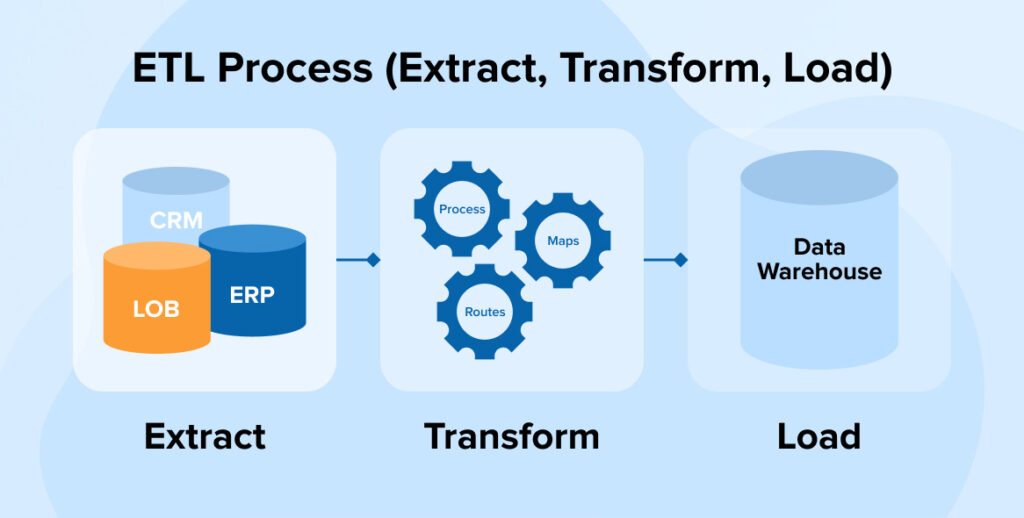What is ETL? A Comprehensive Guide to Data Integration
ETL, or Extract, Transform, Load, is one of the cornerstones of modern data management. In today’s data-driven world, businesses have to collect large amounts of data from different sources and transform it into meaningful information. This is where ETL comes into play! This process, which is used to bring your data together, organize it and make it ready for analysis, is indispensable for both small businesses and giant organizations.

What is ETL?
ETL is a data integration process in which data is extracted from a source (Extract), transformed (Transform) and loaded into a target data store (Load), making it ready for analysis. This process is used to combine data from different systems and bring it into a standardized format. For example, an e-commerce company may want to combine customer data from the CRM system, sales data from the ERP system and website analytics from Google Analytics into a data warehouse. ETL enables this data to be harmonized.
The main goal of ETL is to transform raw data into meaningful, usable and consistent information. This process plays a critical role in areas such as data analytics, business intelligence (BI) and machine learning.
Stages of the ETL Process
As the name suggests, this process consists of three main phases. Each stage is critical to the success of data integration. Let’s examine these stages in detail:
1. Extract
The extraction phase involves collecting data from different sources. These sources can be databases, APIs, CSV files, cloud-based applications or even social media platforms. For example, a retail company might collect data from point-of-sale systems, online store data and customer surveys.
Things to consider at this stage:
Data Source Diversity: Data can be in structured (such as SQL databases) or unstructured (such as log files) formats.
Data Quality: Missing, erroneous or inconsistent data should be filtered out during extraction.
Performance: With large data volumes, extraction must use system resources efficiently.
2. Transform
Transformation is the stage where raw data is made available for analysis. In this process, data is cleaned, formatted and standardized. For example, merging date formats, completing missing data or standardizing different terms that mean the same thing is done at this stage.
Some of the techniques used in the transformation process:
Data Cleaning: Removing duplicate records, correcting erroneous data.
Data Enrichment: Adding additional information to the data (e.g., enrichment with geographic data).
Data Normalization: Bringing data in different formats to a single standard.
Data Aggregation: Summarizing the data, for example converting daily sales into monthly totals.
This phase is the most complex part of the ETL process because the quality and consistency of the data is determined here.
3. Load
The loading phase is the transfer of the transformed data to a target data store (usually a data warehouse or database). The loading process can be either full load or incremental load:
Full Load: All data is loaded into the target system from scratch.
Incremental Load: Only new or updated data is loaded, which is faster and more efficient.
During loading, data consistency and performance optimization are critical. For example, when loading into a data warehouse, techniques such as indexing and compression can be used to speed up the process.
What are the Advantages of ETL?
Why is ETL so popular in data integration? Here are the main advantages of ETL:
Data Consistency: Combines data from different sources to create a consistent data set.
Preparation for Analysis: Facilitates business intelligence and reporting processes by bringing data into an analyzable format.
Automation: ETL tools save time by automating manual data handling processes.
Flexibility: It can work with different data sources and formats, making it suitable for any industry.
Data Quality: Improves data quality through cleansing and transformation.
ETL Tools and Technologies
There are many tools and technologies available to facilitate ETL processes. Popular ETL tools include the following:
Apache NiFi: Open source, powerful tool for managing data flows.
Talend: User-friendly interface, suitable for both small and large-scale projects.
Informatica PowerCenter: A comprehensive solution for enterprise-grade data integration.
Microsoft SSIS: A powerful ETL tool that integrates with SQL Server.
AWS Glue: A service from Amazon for cloud-based data integration.
These tools automate ETL processes, making data management more efficient for businesses.
Differences between ETL and ELT
To better understand ETL, let’s take a look at the differences between it and the often confused ELT (Extract, Load, Transform):
ETL: Data is first transformed and then loaded into the target system. More suitable for traditional data warehouses.
ELT: Data is first uploaded to the target system and then transformed. Preferred for cloud-based data lakes and big data platforms.
Which method to choose depends on data volume, infrastructure and analysis needs.
Use Cases of ETL
ETL is widely used in different industries and scenarios:
Business Intelligence (BI): Creating sales reports, customer analytics and performance indicators.
Data Migration: Transferring data from old systems to new systems.
Data Warehouse Management: Consolidating large data sets and making them ready for analysis.
Machine Learning: Preparing training datasets and data integration for modeling.
Best Practices in the ETL Process
To get the most out of ETL processes, it is important to follow some best practices:
Focus on Data Quality: Clean and accurate data increases the reliability of analysis results.
Embrace Automation: Reduce the risk of errors by minimizing manual processes.
Optimize Performance: For large data sets, use techniques such as parallel processing and indexing.
Take Security Measures: Implement encryption and access controls to protect sensitive data.
Document: Facilitate future maintenance and updates by documenting ETL processes.
Ultimately, ETL is the backbone of data integration and enables businesses to get the most out of their data. Extract, Transform and Load stages combine data from different sources and make it ready for analysis. With the right tools and best practices, ETL processes make it easier for businesses to make data-driven decisions. If you want to stay one step ahead in the data world, start discovering the power of ETL!


